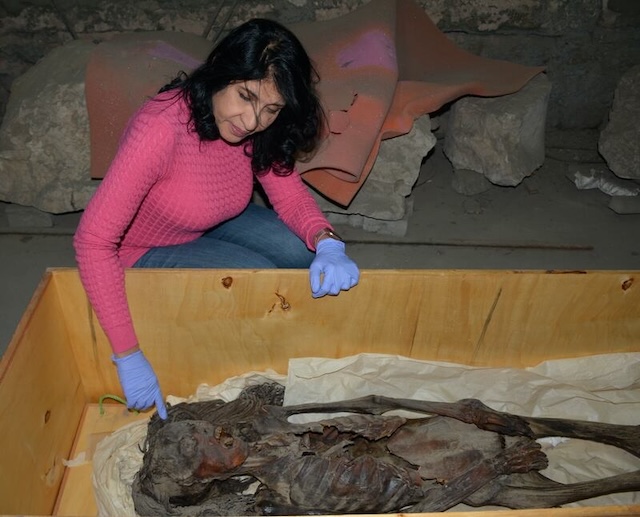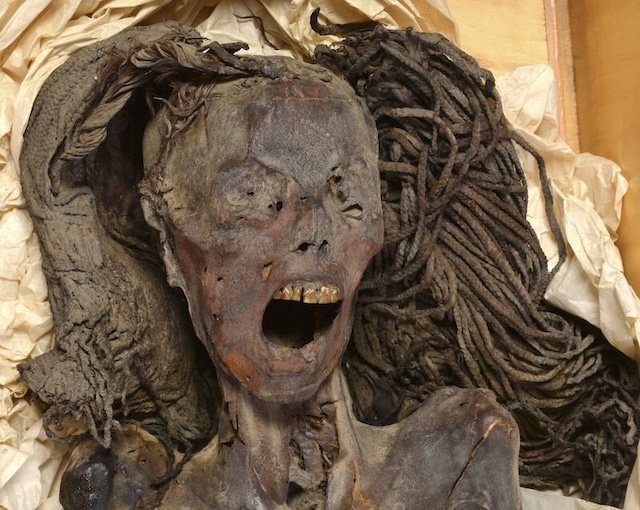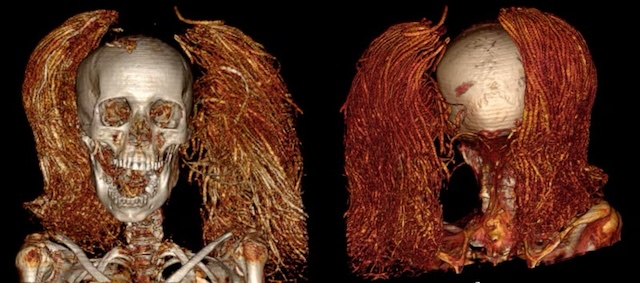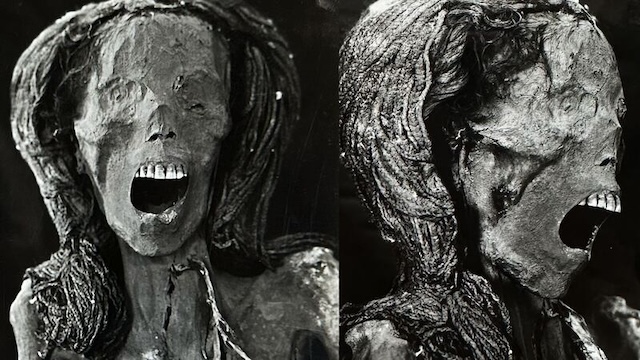The discovery of the “Screaming Woman” mummy in Egypt has puzzled archaeologists and captivated the world for decades. Found beneath the tomb of Senmut near Luxor in 1935, the mummy’s open-mouthed expression hints at a mysterious, agonizing death. Now, thanks to modern technology, researchers have revealed fascinating details about her mummification and her final moments. Advanced techniques such as CAT scans and infrared imaging have shed light on this chilling figure, providing deeper insights into ancient Egyptian burial practices and her enigmatic demise.
Discovery of the ‘Screaming Woman’
In 1935, during an excavation near Luxor, Egypt, archaeologists from the Metropolitan Museum of New York made a chilling discovery. Beneath the tomb of Senmut, the architect and overseer of royal works for Queen Hatshepsut, a wooden coffin was unearthed. Inside lay the well-preserved mummy of an elderly woman whose mouth was locked open in a haunting, eternal scream. This eerie mummy has since been dubbed the “Screaming Woman,” and her disturbing expression has captivated researchers and the public for nearly a century.
Modern Technology Sheds New Light
In a recent study published in the journal Frontiers in Medicine, researchers have used advanced technology to unlock some of the mysteries surrounding the life and death of the Screaming Woman. The research team, led by Dr. Sahar Saleem, professor of radiology at Kasr Al Ainy Hospital of Cairo University, utilized a range of sophisticated methods including CAT scans, scanning electron microscopy, and infrared imaging to virtually dissect the mummy. This groundbreaking analysis offers fresh insights into her physical condition, her death, and the unique mummification process used on her body.

Rich Embalming Materials and an Enigmatic Preservation
Contrary to earlier beliefs that her open-mouthed expression indicated poor mummification, researchers discovered that the Screaming Woman had been embalmed with expensive, imported materials. This suggests she was a person of considerable status. According to Dr. Saleem, the embalming materials included juniper imported from the Eastern Mediterranean and East Africa, and frankincense, possibly sourced from Southern Arabia. These substances were highly valued in ancient Egypt and would only have been used for someone of importance.
Her hair, still preserved after 2,500 years, had been dyed with henna and juniper, and her wig was treated with quartz, magnetite, and albite crystals to stiffen it. These materials were chosen to enhance the black color, a symbol of youth in ancient Egyptian culture.
Unusual Mummification Practices
The study revealed that the Screaming Woman’s internal organs—brain, diaphragm, heart, lungs, liver, spleen, kidneys, and intestines—were still intact. This was highly unusual, as mummification during the New Kingdom period (1550–1069 BCE) typically involved the removal of most organs, leaving only the heart. The preservation of her internal organs, despite her mummified condition, indicates that a different technique was employed, perhaps indicating either a deliberate choice or a special process reserved for particular individuals.
Theories on Her Death: Agony or Cadaveric Spasm?
While researchers have yet to determine the exact cause of death, her death remains shrouded in mystery. The Screaming Woman’s agonized facial expression has led to several hypotheses, with the most prominent theory being that she experienced a violent or painful death. Dr. Saleem suggests that the open-mouthed scream may be the result of a cadaveric spasm, a rare phenomenon that occurs during death under extreme physical conditions or intense emotional stress. This theory posits that the woman may have died in great agony or pain, locking her face into this unnerving expression.
A cadaveric spasm, also known as the “instantaneous rigor,” could have caused the muscles in her face to stiffen before death, creating the illusion of a scream. This explanation offers a chilling glimpse into her possible final moments and suggests a violent or unexpected end.

Age and Physical Condition
Analysis of the mummy indicates that the Screaming Woman was approximately 48 years old at the time of her death. She stood around five feet tall and suffered from mild arthritis of the spine, which is typical of her age. Researchers also found evidence of dental issues, with several teeth missing, likely extracted due to decay or infection. These findings provide a broader understanding of her life and the physical hardships she endured before her untimely death.
Embalming Techniques Reveal Ancient Trade Networks
One of the most intriguing aspects of this study is the insight it provides into ancient Egypt’s international trade networks. The expensive embalming materials used on the Screaming Woman’s body—particularly the imported juniper and frankincense—suggest a well-established and far-reaching trade system that extended beyond Egypt’s borders. The presence of these foreign materials in her mummification highlights Egypt’s connections to other regions and underscores the importance of trade in obtaining these valuable substances.
A Time Capsule of Ancient Egyptian Death and Burial Practices
The Screaming Woman’s remains offer an extraordinary glimpse into ancient Egyptian mummification and burial practices. Despite the presence of these costly embalming materials, the fact that her organs were not removed is perplexing, especially given that organ removal was standard practice during her time. The study suggests that she may have undergone a unique or experimental embalming process.
As Dr. Saleem noted, the Screaming Woman serves as a “time capsule,” preserving both the moment of her agonizing death and the care taken to embalm her remains. This discovery not only deepens our understanding of ancient burial rituals but also serves as a reminder of the complexities surrounding death and the afterlife in Egyptian culture.
Her Final Resting Place: Mummy and Coffin Separated
Since her discovery in 1935, the Screaming Woman and her coffin have been separated. The mummy was initially kept at the Kasr Al Ainy School of Medicine in Cairo, where it was studied by medical experts. In 1998, she was transferred to the Cairo Egyptian Museum, where she has since been displayed. Her wooden coffin, along with the two scarab rings discovered beside her, remains on display at the Metropolitan Museum of New York.
This separation of the body and coffin is a notable aspect of the Screaming Woman’s posthumous journey, highlighting the complex history of her discovery and the international interest in ancient Egyptian artifacts.
Ongoing Research into Ancient Egyptian Remains
As researchers continue to apply advanced technologies to the study of ancient mummies, the Screaming Woman’s case illustrates how much more there is to uncover about Egypt’s past. With tools like CAT scans, electron microscopy, and infrared imaging, scientists are now able to reveal new details about ancient individuals’ lives, health, and burial practices that were previously impossible to discern. The findings of this study emphasize that there are still many secrets to be uncovered from Egypt’s rich and fascinating past.
The Screaming Woman, with her haunting expression and intricate mummification, remains one of the most enigmatic and unforgettable figures in the world of archaeology, offering a chilling reminder of life, death, and the ancient traditions that sought to preserve them for eternity.

Conclusion
The “Screaming Woman” offers a rare glimpse into both the life and death of an individual from ancient Egypt, preserved for millennia in a haunting state. Her agonized expression, now believed to be the result of a cadaveric spasm, paints a chilling picture of her final moments, while the intricate embalming techniques used to preserve her remain a testament to the complexity of ancient Egyptian mortuary practices. As research continues, her case reminds us that even in death, these ancient figures can tell us much about the past, opening doors to new understandings of history, culture, and the enduring mystery of the human experience.
